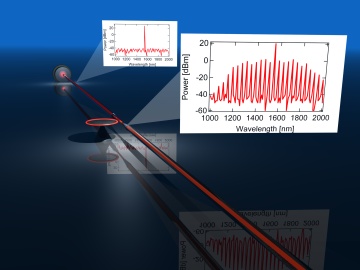| SCHIBLI−LAB AT THE UNIVERSITY OF COLORADO |  |
||
|---|---|---|---|
| We make light shine! | |||
| Ultra high-Q optical microresonators | ||||||
| An optical cavity
or optical resonator
is an device that forms a standing wave (in case of a linear
arrangement) or a traveling wave (in case of ring-like arrangement) for
light waves. Optical cavities are a major component of lasers,
surrounding the gain medium and thus providing feedback of the laser
light. They are also used in optical parametric oscillators, in some
interferometers or in ultra-sensitive detection systems. Optical
resonators are typically formed by a set of mirrors arranged in a way
to reflect light onto itself, i.e. light of a specific frequency will
be trapped inside the resonator. Depending on the
reflectivity of
the mirrors, Q-factors of the order
of ten to one hundred billions can be achieved. A major drawback of optical resonators formed by mirrors is their bulkiness and sensitivity to environmental influences. One has to go great lengths to sufficiently isolate an optical resonator from environmental influences to be able to either reach the quantum or thermal noise limit. Entirely without mirrors, optical cavities can also be formed by what is known as total internal reflection. In this case, light is trapped inside a transparent medium with a refractive index that is higher than the refractive index of the environment. In the simplest case, such resonators can be produced by melting the tip of an optical fiber, which results in a tiny glass sphere measuring only a few 100 microns in diameter. The high purity of the fiber material allows optical Q-factors in excess of a billion. Therefore, practically by melting a piece of glass, optical resonators with Q-factors in excess of ten billions can be obtained. This is thousands of times better than the world's best quartz crystals. A more elaborate way of producing toroidal structures and many interesting applications can be found here. Such cavities are interesting candidates for a large variety of applications, such as cavity quantum electro dynamics, sensing of single atoms or molecules or for a variety of cavity optomechanics experiments. If one could fully exploit the high Q-factors of such structures, tiny ultrastable optical oscillators might become feasible. |
 Artist’s vision of a spherical microresonator obtained from melting the end of an optical fiber. The diameter of the sphere is approximately 0.3mm. The red line on the right is an optical fiber that carries the light to and from the optical resonator. |
|||||
... practically by melting a piece of glass, optical resonators with Q-factors in excess of ten billions can be obtained. This is thousands of times better than the worlds best quartz crystals. |
||||||
 A toroidal microcavity on a silicon chip. The disk is made from SiO2, which was melted for a very brief moment to form the smooth ring structure, which guides the light inside the glass. |
||||||
| Early optical frequency combs were based on intracavity phase modulation and more recently on phase-stabilized mode-locked lasers. A new approach promises to shrink the size and complexity of optical frequency comb generators by many orders of magnitudes. The approach is based on cascaded four-wave mixing (FWM) inside ultrahigh-Q optical Whispering Gallery Mode (WGM) resonators. The high-Q factors and small mode-volumes lead to large intracavity intensities at low input powers. Del'Haye etal. have shown, that with as little as 200mW octave spanning combs can be realized. |  Optical frequency combs can be generated by cascaded four wave mixing inside high-Q optical micorotoroids. |
|||||
| <Back |
||||||